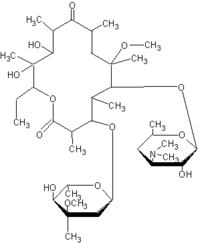Resistance to antibiotics by pathogens is an increasingly serious problem worldwide. By 1999, approximately 25 percent of isolates from invasive infections caused by Streptococcus pneumoniae in the United States and many other countries were resistant to macrolides. This rapid increase followed the introduction of the new macrolides azithromycin (Zithromax) and clarithromycin (Biaxin). Macrolide resistance was predominantly reported in pneumococcal serotypes 14, 19F, 19A, 6B, 6A, and 23F. Four of these subtypes (6B, 14, 23F, and 19F) were targeted in the 7-valent pneumococcal conjugate vaccine (Prevnar) introduced for use in young children in the United States in 2000. Stephens and colleagues studied the impact of the vaccine on macrolide resistance in invasive pneumococcal disease.
The authors used data from prospective, population-based surveillance systems that provided information about patient characteristics and the pneumococcal organisms involved in all invasive pneumococcal disease in the Atlanta metropolitan area since 1994. The study included all samples in which pneumococci were grown from normally sterile sites such as blood or cerebrospinal fluid (CSF). Data on invasive pneumococcal disease were correlated with information on coverage of pneumococcal immunization obtained from national surveys.
Between 1994 and 2002, researchers identified 6,695 invasive pneumococcal infections. The proportion of isolates available for testing ranged from 77 to 87 percent. Recurrent episodes of infection in the same patient were counted as separate infections. Blood accounted for 95 percent of isolates, with 3.5 percent from CSF or CSF and blood, and 1.5 percent from joints, pleural fluid, and other sites. The mean annual incidence of invasive pneumococcal disease decreased from 30.2 infections per 100,000 persons from 1994 to 1999 to 13.1 infections per 100,000 persons in 2002. The decline was most evident in children younger than two years. In this age group, the incidence of invasive pneumococcal disease decreased 82 percent, from the mean annual incidence of 278 infections per 100,000 persons from 1994 to 1999 to 50 infections per 100,000 persons in 2002. In children two to four years of age, there was a 71 percent decrease. Adults had decreases of 54 percent in patients 20 to 39 years of age, 25 percent in patients 40 to 64 years of age, and 39 percent in patients 65 years and older. The incidence of invasive pneumococcal disease decreased by 63 percent in blacks and 54 percent in whites. Substantial decreases were documented for vaccine serotypes 14 (92 percent), 6B (53 percent), 19F (84 percent), and 23F (76 percent).
Three years after the pneumococcal vaccination was introduced in the United States, an estimated 80 percent of U.S. children 19 to 35 months of age had received two doses, but less than 30 percent received the full four-dose series. In the six years before the vaccine was introduced (1994 to 1999), the incidence of macrolide-resistant disease grew rapidly to 9.3 per 100,000. By 2002, the incidence of macrolide-resistant disease decreased to 2.9 per 100,000. The change was most dramatic in children younger than two years of age, in whom a decrease of 85 percent was noted. Significant decreases also were reported in other age groups and in blacks and whites.
The authors conclude that the introduction of pneumococcal vaccination was associated with dramatic decreases in the incidence of invasive pneumococcal disease, particularly in the targeted population groups and in disease caused by the vaccine serotypes. They attribute the changes in antibiotic resistance to the vaccination through direct and indirect (i.e., herd immunity) effects. The decline is predominantly a result of decreased incidence in the serotypes commonly associated with macrolide and other antibiotic resistance. Nevertheless, selective pressure for macrolide resistance persists in the serotypes not affected by the vaccine and in different mechanisms by which the organism develops and spreads resistance. Recent monitoring shows increasing resistance in serotypes 14, 9A, and 33. The authors call for greater efforts to increase vaccination coverage and for continued monitoring of resistance patterns in the pneumococcal organism.
Stephens DS, et al. Incidence of macrolide resistance in Streptococcus pneumoniae after introduction of the pneumococcal conjugate vaccine: population-based assessment. Lancet March 5, 2005;365:855-63.
ANNE D. WALLING, M.D.
COPYRIGHT 2005 American Academy of Family Physicians
COPYRIGHT 2006 Gale Group



